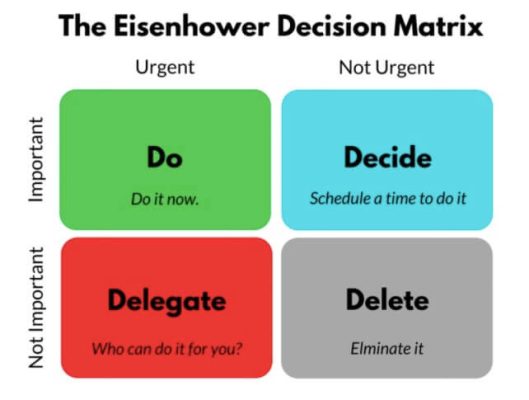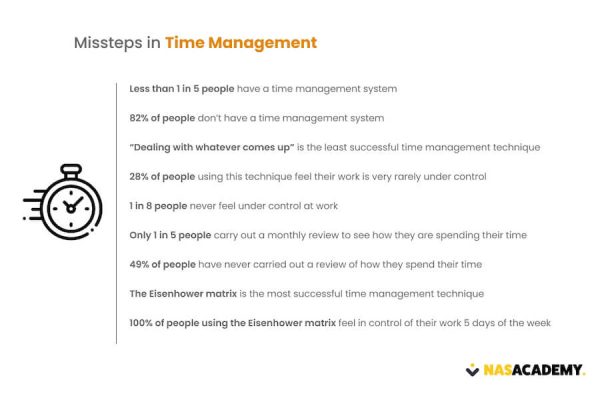https://nasacademy.com/blog/article/6-time-management-tips

Time is money. The problem is: life is hectic, and can get away from us. The solution to this is, of course, time management, and we’ve collected the top time management tips recommended by experts, so you can create some structure in your life, hit those goals, and go to sleep at a decent time.
Time management is a skill we’re all aware of, but not necessarily experts in. In fact, research shows that 82% of workers do not use a time management system of any kind. 28% of workers also feel that their work is very rarely under control. Without having a system in place to manage their time, people tend to procrastinate, prioritize tasks incorrectly and, even if deadlines are met – their work-life balance suffers as a result.

But time management skills can be applied to so much more than your work. Your personal life will also reap the benefits from an efficient time management system. But sometimes, finding where to start can be overwhelming when you are constantly bombarded with different opinions from different people.
That’s why we’ve lined up the top time management tips from real experts to help you get started. First, we’ll take you through one of the most effective time management strategies out there: the Eisenhower Matrix. Then, we’ll go over some useful time management tips to use in addition to your new strategy.
The Eisenhower Matrix is based on US President Eisenhower’s time management strategy. Eisenhower was famous for how much he accomplished in a week, and he credited it all to his time management system. Now, his system has been adapted into what we call the Eisenhower Matrix –which is used by some of the most successful people on the planet. “The 7 Habits of Highly Effective People”, written by Stephen R. Covey, also adapts the Eisenhower Matrix in its strategy.
So why is this system so popular? Well, studies show that 100% of people who use the Eisenhower Matrix feel in control of their lives every day of the week. Compare that to the 1 in 8 people who don’t use a time management system, and feel their work is never under control – it’s a no-brainer!
The Eisenhower Matrix is pretty simple. First, it gets you to organize your tasks into four categories:
Organizing your to-do’s into categories of importance, means you will be able to sort and prioritize them much easier.

Image Credit: https://luxafor.com/the-eisenhower-matrix/
First let’s look at the first two categories: urgent and important.
Urgent tasks are those with approaching deadlines, and need to be completed on a time sensitive basis.
Important tasks are those which benefit your long-term goals, but may not have an urgent deadline.
People have a tendency to prioritize the urgent items on their to-do lists, and wait on the important ones until they become urgent – or simply forgotten.
Unfortunately, the important tasks get forgotten more often than not, in favor of completing the “urgent” ones. While these urgent tasks have deadlines and need to be completed, they often end up taking over your life. Putting all of your energy into only urgent tasks, means you’ll find yourself having accomplished very little that’s meaningful – even though you’re meeting deadlines.
The Eisenhower Matrix addresses this problem by forcing you to think about what will benefit you in the long term, and to write them down. This makes it far more likely that you’ll actually accomplish them and move your career and goals forward. So, while you’ll be completing your urgent tasks and allocating time to them, you’ll also be making time for what’s really important.
This is where the other two categories come in: delegate and delete.

Delegation is one of the most important skills you can learn in your career – no matter what your job is. Yet, people are often reluctant to pass off their assignments to others, as it can come across as lazy. But delegation isn’t lazy – it’s actually very smart.
It means you know your limits, your strengths, and you can predict possible issues that may arise with a task. Delegating a task to someone who’s better suited to do the job isn’t just smart — it’s essential. It frees up your time and allows the task to get done to the best of its ability. Good leaders understand that delegation is crucial for the success of the team – and it’s about time other people in the workplace follow suit.
The final section of the Eisenhower Matrix is “delete”. The tasks in this section are ones that are distracting, have no meaningful purpose, and are better discarded for the good of the group – and yourself. An example could include those bi-weekly meetings that don’t accomplish anything, and where everyone is just mindlessly switching through the apps on their phone.
So, how can you start implementing this matrix into your day-to-day life? Simply spend the last thirty minutes of your work day organizing your tasks into these categories – and you’ll see a difference in no time.
Even when using the Eisenhower Matrix, it can be difficult to know what to prioritize – and simply going through your “urgent” and “important” lists isn’t the way to go. Some items on these lists are going to be more important or urgent than others, and it’s essential to be able to tell the difference when planning your day.
Do the most difficult tasks first. Research shows that people work most effectively between 9am and 10am. Leave the easier tasks to the afternoon slump when you don’t need to use as much brain power. Once your biggest tasks are out of the way, the rest will be a breeze.
Although, many of us work from home – and there are many night owls out there who aren’t productive in the mornings. If you’re one of these people, don’t worry. . You don’t have to follow a specific schedule just because that’s what the world says is best. Instead, plan your day around when you are most productive.

However, this can’t apply to people who are required to work specific hours of the day. This approach works best for those work-from-home freelancers, or remote workers with flexible hours. Managing your time and sticking to a schedule that works for you, no matter what that schedule looks like, is one of the most important parts of effective time management.
Now, as you go to set up your schedule, give yourself plenty of time to complete tasks, and don’t underestimate the amount of time required for doing them from start to finish. If you’re taking too long to finish a task, leave it and come back to it later. If you finish earlier than expected, start on tasks due for later so that you can get ahead..
Perfectionism is the common curse of any hard-worker – and it’s a habit that’s difficult to break. It’s easy to fall into the trap of spending too much time on your work with the intention of making it flawless. But the thing is – flawless work isn’t real, and it isn’t something you should be aiming for. Now, this isn’t to say that you shouldn’t do your best, but rather that you should accept your flaws, and know when something is as good as it’s going to get. Then, move onto something else.

Perfectionism is also best friends with procrastination. When you expect everything you produce to be perfect, it creates feelings of anxiety that are very often the cause of procrastination. When you’re worried about not meeting your standards, you fall into the habit of putting things off for as long as possible to avoid failure.
But, when you let go of perfectionism, you might notice your work actually gets better. You will start to practice more, see your strengths, meet deadlines, become more confident – and you’ll be far more open to taking risks.
Having a to-do list isn’t enough to effectively manage your time — you need to put your list into a schedule.
Set aside some time at the end of your day to do this, so that you can get started on tasks as soon as possible in the morning. Use prioritization here to schedule your most important and urgent tasks first, and leave anything less urgent for later in the day – but still leave enough time to get them done. Also remember to schedule tasks due later in the week.
Remember to add in buffer time in your schedule. Running from one meeting to another and doing tasks continuously without a break is a formula for a mental breakdown. Buffer time will give you a ten-minute break between tasks, and it gives you some leeway in case something takes longer than anticipated to complete. Buffer time gives you flexibility in your schedule, and will ultimately make your life more manageable.

Creating a schedule is easier now more than ever before. Use a physical planner, a notebook or try bullet journaling if you’re a creative person. Bullet journaling lets you organize your planner however you like, and makes your schedule more attractive to read – not to mention, it’s design and creative nature will make it more likely that you’ll stick to it.
There are also many online resources for scheduling, like Google calendar or Asana. These online resources and apps are handy, as you can set timers to remind yourself of meetings or deadlines in case you get carried away by a task.
It’s easy to get preoccupied with “busy work”, until you look up and realize half the day has passed. Email is especially a trap, as people get carried away replying to one after another as they come in. But this can be a big problem – it means that you’re getting stuck working on small tasks, and neglecting the important ones.
One time management strategy to solve this problem is to schedule time to address busy work, and only do your busy work in this block. Set aside an hour in your day to respond to emails and messages, and resist the urge to return to them outside of this block. If you find you have a constant stream of emails coming in, set shorter blocks of time throughout the day to address them consistently.

You don’t want to become a professional emailer. It’s a waste of your time and your skills. Instead, focus more time on the important tasks that are going to benefit you in the long run.
Start saying no to the people in your life. Yes, we mean it!
Now, this isn’t an invitation to say no to everything, and become a jobless recluse – but too often we agree to tasks that we’re either not qualified for, or simply don’t have the time to do. Learning the value of saying “no”, will make your life and the lives of your team better. You can focus on what you need to do, and people won’t be waiting on you for work you’re struggling to complete. This ties into the “delegate” and “delete” sections of the Eisenhower Matrix. By saying no, you are actually putting it into practice.
We’ve brought together the top CEOs, founders, and career experts to form a business learning community. Whether you’re looking to pivot your career, pitch your billion-dollar idea to investors, or want to become a digital nomad, you’ll learn all this and so much more in this Nas Academy Business Community designed to guide and support.
This community offers a safe space to network, learn, and collaborate with some of the most innovative thinkers around the world. On top of that, we’ve pooled all our resources to give you access to thousands of dollars worth of Nas Academy classes and resources – all under 1 subscription.
By subscribing to the Nas Academy Business Community, you’ll also be invited to join exclusive events and workshops with renowned guest speakers – an opportunity that you won’t easily find anywhere else. So, if you’re looking for people who share your interests and will support your career journey, subscribe today and see how much your life will change.
By Admin Nas Academy
By Admin Nas Academy